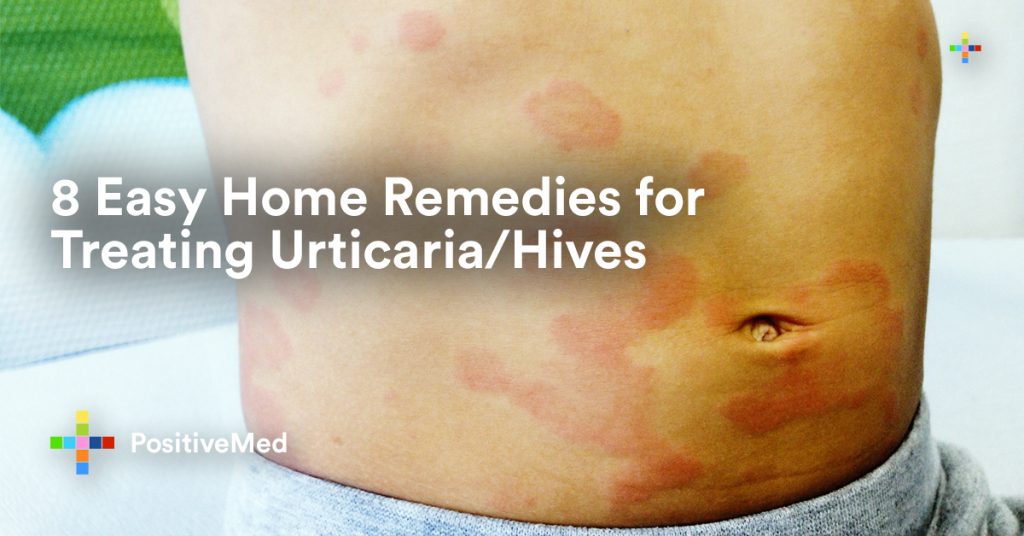Urticaria is an annoying allergic condition that can be extremely troubling at times. If you are suffering from urticaria, you are probably aware of how it can significantly impair one’s sleep cycle and overall quality of life.

According to an article published in the American Family Physician, urticaria has a lifetime prevalence of 2o percent. Urticaria (also referred to as hives or idiopathic urticaria) is a reaction on the skin caused due to certain allergens that you either encounter or consume. When you are exposed to an allergen, your body releases an acidic protein called histamine that is responsible for the intense puristic wheals, itching, inflammation, redness, and swelling in the affected area(s).
Since histamines are the primary culprits for causing the allergic reaction, it is quite possible that your medical practitioner will recommend an antihistamine as the first line of treatment for hives. However, several other natural alternative medicines can alleviate the symptoms of urticaria and reduce its risk in the long term.
Here are eight hand-picked home remedies that have proven to be effective in managing urticaria/hives.
1. Apply a Paste Made of Apple Cider Vinegar and Corn Starch
Apple cider vinegar possesses strong antiseptic, anti-inflammatory and antihistamine properties that can help reduce the itching and inflammation associated with urticaria. Because apple cider vinegar is made of apples fermented by yeast and bacteria, it is also rich in probiotics that can help reduce hives.
Prepare a paste of apple cider vinegar and corn starch, and apply on the affected area after a tepid-water bath as the skin can easily absorb the blend. Corn starch also helps soothe skin irritation and welts.
You can also add two cups of apple cider vinegar to a bathtub of warm water. Soak in it once a day for about 20 minutes daily.
Follow any one of the above-mentioned methods daily until you see a marked improvement in your condition.
2. Include Turmeric in Your Daily Diet
The golden spice, turmeric possesses antihistamine, anti-inflammatory, antioxidant, antiseptic, and anti-microbial properties that help alleviate the distressing effects of hives. These therapeutic properties of turmeric are attributed to its chemical component, cur-cumin.
Add a teaspoon of turmeric powder to a glass of warm milk. Mix them well and consume this concoction once daily until your eruptions heal. You can add honey to enhance its taste. You can also make turmeric a part of your daily diet by including it in your everyday meals.
3. Soothe the Inflamed Area with Ginger
The inflammation caused due to hives causes a sudden rush of blood in the capillaries. This leads to swelling and redness. Because of its anti-inflammatory properties, ginger improves the circulation around the inflamed area by targeting the genes and enzymes responsible for the pain and swelling.
Boil one-fourth cup brown sugar, a tablespoon of crushed ginger, and three-fourth cup vinegar together for three minutes. Cool this concoction and dilute it with water before dabbing it on the welts. Apply this brew three to four times a day until your skin heals completely.
Alternatively, you can chew on a piece of ginger or consume ginger tea on a regular basis.
4. Use Baking Soda to Reduce Irritation
Hives are acidic in nature, while baking soda (or sodium bicarbonate) is alkaline, which helps neutralize the acid. Baking soda is available in almost every kitchen and is an extremely common and effective home remedy for treating hives. It possesses potent anti-inflammatory features that can reduce swelling and inflammation.
Mix a tablespoon of baking soda with enough water to make a thick paste. Apply this paste on the rashes and welts and leave it on for about twenty minutes. Do this once daily until the hives are gone.
5. Apply a Cold Compress of Mint Solution
Mint possesses strong antioxidant properties that help in soothing the burning and itching sensation on the skin. The menthol present in this herb offers a cooling effect, and this makes mint an amazing herb for suppressing hives.
Crush 4-5 mint leaves and add these to a cup of boiling water. Once the solution is at room temperature, place it in the refrigerator to cool it down further. Soak a soft towel in this cool mint solution and dab it on the affected area for about 15 minutes. Repeat this three to four times daily until you feel relieved.
6. Consume Licorice Root Tea Regularly
Licorice root is proven to possess anti-inflammatory properties similar to those found in steroids. It has been used for centuries to treat a wide variety of ailments including chronic urticaria.
Crush a handful of licorice roots and infuse them in a cup of hot water for about five to ten minutes. Strain and consume this solution instantly. Licorice root is naturally sweet to taste, so you may not feel the need to add sugar/honey. Consume licorice root tea two to three times daily to soothe the inflammation and pain associated with urticaria.
7. Use Chamomile Tea to Alleviate Stress-Induced Urticaria
In numerous cases, it is tough to determine the underlying cause of hives. In such cases, it is often seen that even a stressful event can trigger erratic skin welts.
Chamomile is a wonder-herb that offers much-needed relief in stress-induced urticaria. It is one of the most ancient herbs known to mankind. Owing to its soothing properties, chamomile has been trusted to relieve stress and anxiety for centuries.
Brew a few chamomile leaves or tea bags for about ten minutes in hot water. You can consume the tea as is or add honey/sugar to enhance its taste. Consume three to four cups of chamomile tea daily to help relieve stress-induced hives.
8. Apply Oatmeal Compress to the Affected Area
If you think oatmeal can only offer you dietary fiber, you need to think again! Uncooked oatmeal can help relieve the persistent itching sensation in urticaria. The anti-inflammatory and soothing properties of oatmeal work well for relief against hives. Use this remedy in conjunction with any of the other treatments mentioned above to experience faster resolution of symptoms.
Make an oatmeal compress to reduce the itching in the affected area. Place a handful of oatmeal on a piece of cotton cloth placed in a bowl. Pour a little warm water over it and let the oatmeal soak for about two to three minutes. Tie the cloth to form a warm compress and dab it on the eruptions. Use this compress daily in your bath to reduce inflammation.
Urticaria can be extremely uncomfortable, especially when it develops suddenly and unexpectedly. This condition can ruthlessly affect your normal life. Fortunately, you can depend on Mother Nature for simple remedies that can help alleviate the symptoms and effects of hives. The aforementioned home remedies will help you better manage the breakouts and reduce the risk of developing urticaria in the long term.






